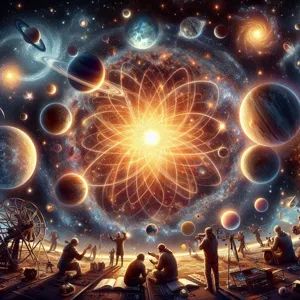The Sun, our closest star, has been a source of wonder and fascination throughout human history, illuminating the skies and nurturing life on Earth.
Yet, despite its central role in our solar system, much about its intricate workings remains cloaked in mystery. How do scientists peel back the layers of this fiery giant to reveal its hidden composition? In this captivating blog post, we will embark on a journey through the innovative techniques and groundbreaking technologies that researchers employ to decode the sun‘s secrets. From helioseismology, which studies the oscillations of solar waves, to advanced spectroscopic methods that analyze solar light, we will explore the remarkable tools and discoveries that have transformed our understanding of the Sun’s structure and behavior. Join us as we unravel the layers of this magnificent star and uncover the secrets that fuel its brilliance, illuminating not just our skies, but also the very fabric of the universe.
1. Introduction to the Sun: Our Closest Star

The Sun, a dazzling ball of fiery plasma, is not only the cornerstone of our solar system but also the very source of life on Earth. Located approximately 93 million miles away, this celestial giant accounts for over 99% of the solar system’s total mass, exerting a gravitational pull that keeps the planets, asteroids, and comets in their orbits. Its surface temperature hovers around a blistering 5,500 degrees Celsius (9,932 degrees Fahrenheit), while its core reaches an astonishing 15 million degrees Celsius (27 million degrees Fahrenheit).
As a G-type main-sequence star, or G dwarf star, the Sun operates on a delicate balance of nuclear fusion, where hydrogen atoms collide and fuse to form helium, releasing an immense amount of energy in the process. This energy not only illuminates our days but also drives the complex systems of weather and climate on Earth. Despite being our closest star, the Sun remains a subject of intense research and intrigue, as scientists strive to unravel its hidden composition and understand the intricate processes that govern its behavior.
Through innovative techniques in astrophysics, such as spectroscopy and helioseismology, researchers are piecing together the Sun’s enigmatic nature. By analyzing light emanating from its surface and studying vibrations within its structure, scientists can infer the elements present in its outer layers and get a glimpse into the dynamics of its interior. As we embark on this journey to discover the Sun’s hidden composition, we gain not only knowledge about our own star but also insights into the formation and evolution of other stars throughout the universe. Join us as we explore the fascinating world of solar science and uncover the secrets of our radiant neighbor in the cosmos.
2. The Importance of Understanding the Sun’s Composition
Understanding the Sun’s composition is not just a matter of scientific curiosity; it is fundamental to our knowledge of the universe and the intricate mechanisms that govern it. The Sun, a vast ball of hot plasma, makes up about 99.86% of the total mass of our solar system. This immense gravitational force plays a crucial role in maintaining the orbits of the planets, including Earth, and ultimately supports life as we know it. By unraveling the Sun’s composition, scientists can gain insights into the processes that fuel its nuclear fusion reactions, which in turn produce the energy that warms our planet and drives our climate systems.
Moreover, the Sun’s composition acts as a cosmic laboratory, offering clues about stellar evolution and the life cycles of stars. By studying elements like hydrogen, helium, carbon, and heavier metals found in the Sun, researchers can construct models of how stars are born, evolve, and die. This knowledge extends beyond our solar system, informing our understanding of other stars and planetary systems throughout the galaxy.
Additionally, understanding the Sun’s makeup is vital for predicting its behavior, including solar flares and coronal mass ejections, which can have significant effects on Earth’s magnetosphere and can disrupt communication systems, navigation, and even power grids. As we face an ever-increasing reliance on technology, the implications of solar activity become more pronounced, making it essential to monitor and comprehend the Sun’s composition and its dynamic activity.
In essence, the study of the Sun’s composition is a gateway to understanding fundamental astrophysical phenomena, the evolution of our solar system, and the intricate relationship between our star and the life that thrives on our planet. As scientists continue to explore the Sun’s secrets, they unravel not only the mysteries of our closest star but also the cosmic narrative that connects us to the wider universe.
3. Historical Perspectives on Solar Composition

Understanding the Sun’s composition has been a journey spanning centuries, marked by the evolution of scientific thought and the gradual unveiling of the intricacies of our nearest star. In ancient times, the Sun was revered as a deity, a source of light and life that governed the rhythms of nature. Early civilizations, like the Egyptians and the Greeks, personified the Sun and intertwined its movements with their myths and agricultural practices, but they had little understanding of its physical makeup.
Fast forward to the Renaissance, where curiosity and observation began to reshape our comprehension of the cosmos. Pioneers like Galileo Galilei turned telescopes toward the heavens, revealing sunspots and challenging the notion of the Sun as a flawless celestial body. Yet, it wasn’t until the 19th century that significant strides were made in understanding solar composition through spectroscopy — the study of light. Scientists like Joseph von Fraunhofer and Gustav Kirchhoff discovered that the Sun’s light could be analyzed to reveal the presence of various elements, leading to the groundbreaking realization that the Sun, much like Earth, was composed of a complex mix of gases.
The advent of the 20th century brought with it a deeper understanding of atomic structure and nuclear fusion, altering our views once again. Theories proposed by scientists such as Hans Bethe explained how the Sun generates energy through fusion processes that convert hydrogen into helium at its core, a revelation that not only informed us about the Sun’s composition but also about its lifecycle and the life-giving energy it provides our planet.
As we moved into the modern era, technological advancements in space exploration and observational tools have allowed scientists to probe the Sun’s interior and atmosphere with unprecedented detail. Missions like NASA’s Solar Dynamics Observatory and the Parker Solar Probe are now providing real-time data on solar activity, helping to uncover the Sun’s hidden layers and its magnetic fields.
Today, the historical perspectives on solar composition serve as a testament to humanity’s relentless pursuit of knowledge. Each breakthrough builds upon the last, revealing a more nuanced picture of our Sun, one that is not merely a fiery sphere in the sky, but a dynamic entity that influences not just our solar system, but the very fabric of space itself. This rich tapestry of history not only enhances our understanding of the Sun but also deepens our appreciation for the scientific method and the quest for discovery that defines human ingenuity.
4. Key Elements of the Sun: Hydrogen and Helium
The Sun, a mesmerizing ball of plasma that lights up our solar system, is primarily composed of two elements: hydrogen and helium. These two gases are not just the building blocks of our star; they are also pivotal to understanding the intricate processes that fuel the Sun’s brilliance.
Hydrogen, the most abundant element, accounts for about 74% of the Sun’s mass. This lightest element is a fundamental player in the nuclear fusion reactions that occur in the Sun’s core. Here, under the immense pressure and temperature, hydrogen nuclei collide and fuse to form helium, releasing an extraordinary amount of energy in the process. This energy manifests as the sunlight that bathes our planet, enabling life as we know it.
Helium, though constituting only about 24% of the Sun’s mass, is just as crucial. It is the product of hydrogen fusion and plays a vital role in the Sun’s lifecycle. As the hydrogen in the Sun’s core gets depleted over billions of years, helium accumulates, leading to changes in the Sun’s structure and energy output. This transformation is what ultimately drives the Sun through its various stages of evolution, from its current state as a middle-aged star to its eventual fate as a red giant.
The balance and interaction between these two elements are what sustain the Sun’s radiance and influence its magnetic field, solar flares, and sunspots. By studying hydrogen and helium, scientists unlock the secrets of stellar dynamics and gain insight into the fundamental processes that govern not just our Sun but stars across the universe. As researchers continue to unravel the complexities of these elements, we edge closer to understanding the very heart of our solar system’s shining beacon.
5. Techniques Used to Analyze Solar Composition

Understanding the Sun’s complex composition requires an array of advanced techniques that blend physics, astronomy, and technology. Scientists have developed several innovative methods to unravel the secrets of our star, each offering unique insights into its structure and behavior.
One of the primary techniques is **spectroscopy**, which involves analyzing the light emitted or absorbed by the Sun. When sunlight passes through a prism or diffraction grating, it disperses into a spectrum of colors. By examining the specific wavelengths of light that are absorbed or emitted, scientists can identify the chemical elements present in the Sun’s atmosphere. Each element has a distinct spectral fingerprint, allowing researchers to determine not only what the Sun is made of but also its temperature, density, and motion.
Another crucial method is **helioseismology**, which studies the oscillations, or seismic waves, produced by the Sun’s turbulent surface. Just as seismologists on Earth analyze the waves generated by earthquakes to infer details about our planet’s interior, helioseismologists measure the Sun’s oscillations to probe its internal structure. These waves provide valuable information about the solar interior, revealing how energy is transported and how the Sun’s layers interact.
In addition to these techniques, scientists utilize **solar telescopes** equipped with advanced imaging technologies to observe the Sun in different wavelengths, from ultraviolet to infrared. These observations help to capture dynamic solar phenomena, such as solar flares and coronal mass ejections, while also offering a clearer picture of the Sun’s outer layers.
Finally, **computer simulations** play a pivotal role in analyzing the Sun’s composition. By modeling the complex interactions of particles and magnetic fields, scientists can predict solar behavior and test hypotheses against observational data. This synergy between observation and simulation allows researchers to refine their understanding of solar dynamics and composition continually.
Together, these techniques form a comprehensive toolkit that scientists employ to decipher the Sun’s hidden composition, shedding light on not only our closest star but also the fundamental processes that govern the universe. As technology advances and new methods emerge, our understanding of the Sun will only deepen, revealing even more about its enigmatic nature.
6. Spectroscopy: Unlocking the Sun’s Secrets
Spectroscopy is a powerful tool that allows scientists to delve into the Sun’s hidden composition, revealing secrets that remain obscured to the naked eye. At its core, spectroscopy involves analyzing the light emitted or absorbed by an object, in this case, our Sun. By dispersing sunlight into its constituent colors—like a prism separating white light into a spectrum—scientists can study the unique patterns of light that emerge. Each element in the Sun’s atmosphere emits or absorbs light at specific wavelengths, creating a distinct fingerprint known as a spectral line.
As scientists observe these spectral lines through sophisticated instruments, they can identify the elements present in the Sun, such as hydrogen, helium, and traces of heavier elements like carbon and iron. This process not only reveals the composition of the Sun but also provides insights into its temperature, density, and even its movement. For instance, the Doppler effect can shift these spectral lines depending on whether the Sun is moving toward or away from Earth, allowing researchers to gauge the dynamics of solar winds and magnetic fields.
Moreover, advancements in spectroscopy have transformed our understanding of solar phenomena. With ground-based observatories and space telescopes like the Solar Dynamics Observatory, scientists can conduct high-resolution observations that unveil the complexities of solar flares and coronal mass ejections. These explosive events, driven by the Sun’s magnetic activity, can have profound effects on space weather, affecting everything from satellite communications to power grids on Earth.
In essence, spectroscopy serves as a cosmic detective tool, unlocking the mysteries of our nearest star. Through its meticulous analysis of light, scientists continue to piece together the intricate puzzle of the Sun’s composition, enhancing our understanding of not only the Sun itself but also the broader universe it inhabits.
7. Solar Flares and Their Impact on Composition Studies

Solar flares, the spectacular bursts of energy that erupt from the sun’s surface, play a pivotal role in our understanding of the sun’s hidden composition. These violent explosions release an immense amount of energy, resulting in the ejection of solar material into space and creating a cascade of fascinating phenomena that scientists are eager to study. When these flares occur, they not only provide a spectacular light show visible from Earth but also serve as a natural laboratory for researchers seeking to unravel the sun’s mysteries.
The particles expelled during a solar flare can carry information about the sun’s magnetic field and the composition of its outer layers. By analyzing the spectral data produced during these events, scientists can glean insights into the elements present in the sun’s atmosphere, including hydrogen, helium, and trace amounts of heavier elements like carbon and oxygen. This information helps to build a more comprehensive picture of the sun’s overall makeup and its dynamic processes.
Moreover, solar flares can impact space weather, influencing satellite operations and communications on Earth. This interaction provides researchers with an opportunity to study how solar phenomena affect not just the sun itself, but also the broader solar system. By monitoring solar flares and their aftermath, scientists can gain valuable insights into the sun’s behavior and its influence on the Earth’s environment.
In essence, solar flares are not just dazzling displays of energy; they are key to unlocking the secrets of the sun’s composition. Each flare is a reminder of the sun’s complexity and the exciting journey scientists embark on to understand our closest star, providing clues that help us appreciate the intricate workings of the universe.
8. The Role of Space Missions in Solar Research
Space missions have played a pivotal role in unraveling the mysteries of our Sun, acting as our eyes and ears in the cosmos. While ground-based observatories provide valuable data, the Sun’s dynamic behavior can only be fully understood by observing it from the vantage point of space. One of the most significant advancements in solar research came with the launch of missions like NASA’s Solar Dynamics Observatory (SDO) and the European Space Agency’s Solar and Heliospheric Observatory (SOHO).
These satellites are equipped with advanced imaging technology that captures the Sun’s surface activity in real-time. By monitoring solar phenomena such as sunspots, solar flares, and coronal mass ejections, researchers can gather crucial insights into the Sun’s magnetic field and the processes that drive solar activity. For instance, the SDO, launched in 2010, continually observes the Sun in multiple wavelengths, revealing the intricate dance of plasma and magnetic forces that characterize its surface.
Moreover, missions like the Parker Solar Probe, which launched in 2018, have brought us closer to the Sun than ever before. This spacecraft is designed to dive into the Sun’s outer atmosphere, or corona, collecting data that could unlock the secrets of solar wind and its impact on space weather. By approaching the Sun at unprecedented distances, the Parker Solar Probe measures the magnetic fields and particle interactions that occur in this extreme environment, providing invaluable information about how solar activity influences Earth’s magnetosphere and atmosphere.
The synergy between these missions not only enhances our understanding of solar dynamics but also improves our ability to predict space weather events that can affect satellite operations, power grids, and even communication systems on Earth. As scientists analyze the wealth of data gathered from these space missions, they continue to piece together the complex tapestry of the Sun’s hidden composition, revealing how our star influences life on Earth and the broader solar system. Through these explorations, we are continuously reminded of the Sun’s intricate nature and its vital role in shaping our cosmic neighborhood.
9. The Sun’s Magnetic Field and Its Implications
The Sun, a radiant ball of gas at the center of our solar system, is more than just a source of light and warmth; it is a complex powerhouse of magnetic activity that has profound implications for both solar dynamics and life on Earth. The Sun’s magnetic field, an intricate web of magnetic lines emanating from its core, plays a pivotal role in shaping solar phenomena such as sunspots, solar flares, and coronal mass ejections. But how do scientists study this elusive magnetic field, and what does it reveal about the Sun’s hidden composition?
At the heart of this exploration is the realization that the Sun’s magnetic field is not static; it undergoes a cyclical transformation known as the solar cycle, lasting approximately 11 years. During this cycle, the magnetic field’s intensity and configuration change, leading to increased solar activity at the peak phase, characterized by more sunspots and energetic solar events. Scientists utilize advanced instruments like the Solar Dynamics Observatory (SDO) and the Solar and Heliospheric Observatory (SOHO) to observe these magnetic changes in real-time, capturing the dynamic interactions between magnetic fields and plasma.
The implications of understanding the Sun’s magnetic field extend beyond mere curiosity. The magnetic activity of the Sun has direct consequences for space weather, which can affect satellites, power grids, and even astronauts in space. When the magnetic field lines become twisted and release their energy through solar flares or coronal mass ejections, the resulting solar wind can induce geomagnetic storms on Earth, potentially disrupting communication systems and navigation.
Moreover, studying the Sun’s magnetic field helps scientists gain insights into fundamental astrophysical processes, including how stars generate and maintain their magnetic fields. By unraveling the intricacies of the Sun’s magnetism, researchers are piecing together the puzzle of stellar behavior throughout the universe.
As our understanding deepens, the Sun reveals itself not just as a solitary star, but as a dynamic, interconnected system—a cosmic entity whose magnetic field holds the keys to understanding both its own nature and the broader mechanisms that govern the universe. Through ongoing research and technological advancements, scientists are poised to unveil even more of the Sun’s hidden composition, illuminating the path for future explorations of our celestial neighbor.
10. Recent Discoveries in Solar Composition
In the ever-evolving field of solar research, recent discoveries have shed new light on the intricate composition of our Sun, revealing complexities that were once hidden beneath its blazing surface. Scientists have made significant strides in understanding not only the elemental makeup of the Sun but also the underlying processes that govern its behavior.
One groundbreaking advancement came from the use of spectrometry, a technique that allows researchers to analyze the sunlight’s spectrum for subtle variations. By examining these variations, scientists have identified trace amounts of elements such as calcium and magnesium, which play essential roles in the Sun’s lifecycle and energy production. These discoveries challenge earlier models that underestimated the abundance of these elements, suggesting a more nuanced understanding of how the Sun generates energy and evolves over time.
Moreover, with the advent of solar observatories equipped with cutting-edge technology, researchers have been able to probe deeper into the Sun’s atmosphere, the corona, and its magnetic fields. The Parker Solar Probe, launched in 2018, has ventured closer to the Sun than any other spacecraft, gathering unprecedented data about solar wind and the dynamics of solar flares. These flares, which can significantly impact space weather and communication systems on Earth, are now better understood thanks to the probe’s findings, including insights into their origin and behavior.
Additionally, recent studies have highlighted the presence of ‘solar waves,’ which are oscillations in the Sun’s plasma. These waves carry valuable information about the Sun’s internal structure and can help scientists predict solar activity. By mapping these waves, researchers are piecing together a more comprehensive picture of solar dynamics, further unraveling the complexities of our star.
As scientists continue to study the Sun’s hidden composition, they are not just unveiling the secrets of our nearest star; they are also gaining critical insights that could inform our understanding of other stars in the universe. Each discovery adds another layer to the intricate tapestry of solar science, bringing us one step closer to comprehending the powerful forces that drive our solar system.
11. The Sun’s Role in Solar System Formation
The Sun, a blazing orb of energy at the center of our solar system, plays a pivotal role in the formation and evolution of its celestial companions. Understanding this role not only sheds light on the Sun’s own composition but also reveals the intricate dance of forces that shaped the planets, moons, asteroids, and comets around it.
Around 4.6 billion years ago, the Sun was born from a swirling cloud of gas and dust, known as a solar nebula. As gravity pulled this material together, it formed a dense core that ignited nuclear fusion, marking the birth of our star. This process released immense amounts of energy, creating solar winds that blew away the remaining gas and dust in the protoplanetary disk, the very material that would eventually coalesce to form planets.
The Sun’s powerful gravitational influence kept this disk in check, allowing particles to collide and stick together, gradually forming larger bodies. It was the heat and light generated by the Sun that defined the habitable zones of our solar system, where conditions were just right for the emergence of life. The inner planets, Mercury, Venus, Earth, and Mars, formed from rocky materials, while the outer planets, Jupiter, Saturn, Uranus, and Neptune, gathered vast amounts of gas and ice, influenced by the Sun’s energy and gravity.
Moreover, the Sun’s composition—predominantly hydrogen and helium—created a unique environment that influenced the chemical makeup of these planets. Heavy elements, forged in the hearts of ancient stars and scattered across the cosmos by supernova explosions, were incorporated into the forming planetary bodies, ultimately leading to the diverse array of worlds we see today.
As scientists continue to unravel the mysteries of the Sun, they gain deeper insights into how this magnificent star not only illuminates our days but also orchestrated the birth of the planets, setting the stage for the dynamic solar system we inhabit. Understanding the Sun’s role in solar system formation is crucial for comprehending the complex processes that govern not just our celestial neighborhood, but potentially others scattered throughout the universe.
12. The Connection Between Solar Composition and Climate
The relationship between the Sun’s composition and Earth’s climate is a fascinating nexus that has captivated scientists for decades. At the heart of this connection lies an intricate dance of elements and energy that influences not only our planet’s atmosphere but also the very foundations of life itself.
The Sun, a colossal ball of gas primarily composed of hydrogen and helium, produces energy through the process of nuclear fusion. This energy radiates outward, providing the light and warmth that sustain life on Earth. However, the subtle variations in the Sun’s composition—such as the presence of heavier elements like carbon, nitrogen, and oxygen—can have profound implications for our climate. These elements play a crucial role in the Sun’s nuclear reactions, and even slight fluctuations can alter the amount of energy emitted.
Recent studies have shown that changes in solar composition can lead to variations in solar output, influencing climate patterns on Earth. For instance, during periods of heightened solar activity, known as solar maxima, the increased emission of solar radiation can contribute to warming trends. Conversely, during solar minima, when activity decreases, Earth may experience cooler temperatures. The historical record, preserved in ice cores and tree rings, provides evidence of these fluctuations, revealing how they align with significant climatic events throughout history.
Moreover, understanding the Sun’s composition helps scientists predict future climate scenarios. By analyzing solar activity alongside greenhouse gas emissions and other anthropogenic factors, researchers can develop more accurate climate models. This holistic approach underscores the importance of solar studies in the broader context of climate science, highlighting how interconnected the systems of our universe truly are.
As we continue to unravel the Sun’s hidden composition, we gain invaluable insights not only into our closest star but also into the intricate web of forces that shape our planet’s climate. This ongoing research not only enhances our understanding of solar dynamics but also equips us with the knowledge necessary to navigate the challenges of a changing climate, emphasizing the timeless bond between the Sun and the world we inhabit.
13. Future Research Directions: What Lies Ahead?
As we stand on the precipice of a new era in solar research, the future holds exciting possibilities for unraveling the mysteries of our closest star. With advancements in technology and innovative research methodologies, scientists are poised to delve even deeper into the sun’s hidden composition. Future research is likely to focus on several key areas.
One significant direction is the exploration of the solar atmosphere, particularly the enigmatic corona, which is much hotter than the sun’s surface. Understanding the mechanisms behind this phenomenon could unlock secrets about solar wind and its influence on space weather, which affects satellite operations and communications on Earth. Researchers are planning to deploy more sophisticated instruments, such as next-generation solar observatories, that can capture high-resolution images and data, allowing for unprecedented insights into coronal dynamics.
Additionally, the study of solar magnetic fields will be crucial. The sun’s magnetic activity drives solar flares and coronal mass ejections, which can have profound effects on Earth and its technological systems. By enhancing our understanding of these magnetic phenomena, scientists aim to develop better predictive models that could mitigate the impacts of solar storms on our planet.
Another promising avenue is the investigation of solar neutrinos—tiny particles produced in the sun’s core during nuclear fusion. Future neutrino observatories are set to improve our understanding of the sun’s inner workings and its energy production processes. By studying these elusive particles, researchers hope to gather data that can refine our models of stellar evolution and behavior.
Lastly, interdisciplinary collaborations will play a vital role in shaping future solar studies. By bringing together experts from fields such as astrophysics, materials science, and computational modeling, scientists can create innovative approaches to tackle the sun’s complexities.
As we look ahead, the field of solar research is not just about understanding the sun itself but also about how it interacts with the wider universe. With each discovery, we inch closer to unraveling the fundamental forces that govern not only our star but also the myriad of celestial bodies that inhabit our galaxy. The quest for knowledge continues, and the implications of these findings could be as illuminating as the sun itself.
14. Implications for Life on Earth and Beyond
The ongoing studies of the Sun’s intricate composition hold profound implications not only for life on Earth but also for the potential for life beyond our planet. As scientists delve deeper into the Sun’s structure, they unravel the mysteries of its elements and isotopes, shedding light on how solar activity influences our climate and ecosystems. Understanding the Sun’s composition allows researchers to predict solar flares and coronal mass ejections—phenomena that can disrupt communication systems, power grids, and even impact global weather patterns.
More intriguingly, the insights gained from studying our Sun can serve as a blueprint for exploring other stars in the universe. By comparing the elemental makeup and behaviors of different stars, scientists can identify which environments might support life. For instance, understanding the balance of hydrogen, helium, and heavier elements in our Sun informs models of star formation and evolution across the galaxy, helping to pinpoint exoplanets that may harbor the right conditions for life.
Furthermore, the quest to understand our Sun feeds into the broader search for extraterrestrial life. Knowledge of how stellar activity affects planetary atmospheres helps astrobiologists assess the habitability of distant worlds. If we grasp how our Sun’s radiation and solar winds shaped Earth’s development, we can apply this understanding to assess whether other planets might experience similar life-sustaining conditions.
In essence, the implications of uncovering the Sun’s hidden composition extend far beyond our own solar system. They invite us to ponder the delicate interplay of cosmic forces that sustain life and encourage us to look outward with curiosity and hope, igniting a passion for exploration in the great cosmic ocean that surrounds us.
15. Conclusion: The Ongoing Quest to Understand Our Star
As we draw our exploration of the Sun to a close, it is essential to recognize that the quest to understand our star is far from over. The Sun, a seemingly familiar fixture in our sky, is a complex and dynamic entity, holding secrets that continue to elude even the most advanced scientific inquiries. Through the combined efforts of solar physicists, astronomers, and space agencies worldwide, we have made significant strides in unveiling the mysteries of solar composition, structure, and behavior.
From the initial observations of its visible surface to the sophisticated analysis of solar winds and magnetic fields, our understanding has evolved dramatically. Instruments such as the Solar Dynamics Observatory and the Parker Solar Probe have provided unprecedented insights, revealing intricate details about solar flares, coronal mass ejections, and the Sun’s magnetic field dynamics. Yet, each revelation prompts new questions, driving scientists to push the boundaries of technology and theory further.
This ongoing quest is not just an academic endeavor; it has profound implications for life on Earth. Understanding solar activity is crucial for predicting space weather events that can disrupt satellites, power grids, and communication systems. Moreover, insights into the Sun’s lifecycle contribute to our broader knowledge of stellar evolution and the fate of other celestial bodies in the universe.
As we forge ahead, the collaborative spirit of the scientific community remains vital. With every new mission launched and every discovery made, we inch closer to comprehensively understanding the Sun—our nearest star and the lifeblood of our solar system. The journey is a testament to human curiosity and ingenuity, reminding us that while we have come far, there is still much more to uncover about the blazing heart of our solar system.
As we conclude our exploration of how scientists unravel the mysteries of the sun’s hidden composition, it becomes clear that our nearest star is far more complex than it appears. Through innovative techniques such as spectroscopy, solar observations, and advanced computational models, researchers have painted a more detailed picture of the sun’s intricate layers and dynamic processes. Each discovery not only enhances our understanding of solar physics but also informs us about the sun’s impact on our planet and the wider universe. As scientists continue to probe deeper into the sun’s secrets, we are reminded of the endless curiosity that drives human exploration. Stay tuned for more updates on this fascinating journey, and let’s continue to marvel at the wonders of our solar system together!

















